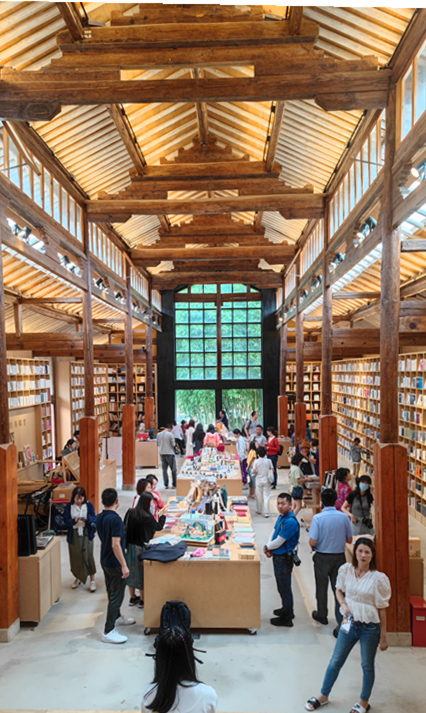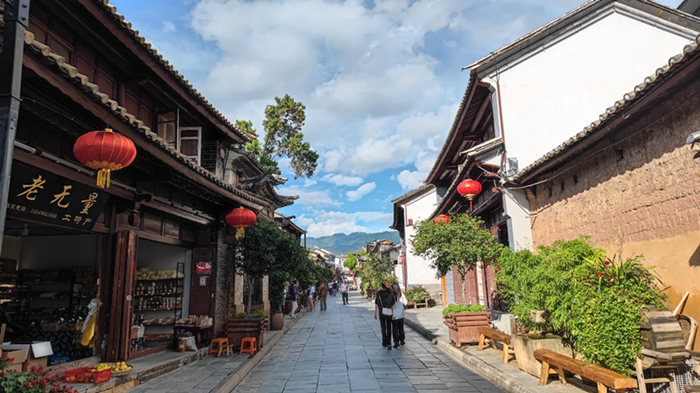|
||||||||||
| Home Nation World Business Opinion Lifestyle ChinAfrica Multimedia Columnists Documents Special Reports |
|
||||||||||
| Home Nation World Business Opinion Lifestyle ChinAfrica Multimedia Columnists Documents Special Reports |
| ChinAfrica |
| Ancient Town, Modern Appeal |
| Dali enhances its charm by preserving and reviving its tangible and intangible heritages |
| By Cui Xiaoqin 丨VOL. 14 September 2022 ·2022-08-30 |

The Librairie Avant-Garde bookstore in the town of Shaxi, Dali Bai Autonomous Prefecture, Yunnan Province
Half of the Chinese people go to Yunnan to escape the heat of summer, and half of them visit Dali. This joke by some Internet users reflects the popularity of Dali Bai Autonomous Prefecture in northwest Yunnan Province as a tourist destination.
Part of the Yunnan-Guizhou Plateau, the prefecture boasts comfortable weather during the summer months. Located at the foot of the snow-capped Cangshan Mountain and on the shores of Erhai Lake, one of China’s biggest freshwater lakes, the area is blessed with breathtaking scenery.
Equally attractive is its rich and diverse culture. Home to 13 ethnic groups who have lived there generation after generation, it has developed unique local culture based on its multi-ethnic character, attracting a great number of tourists from home and abroad.
Lively ancient towns
Dali has stunning ancient architecture featuring stark styles of local ethnic groups. In the county of Weishan, which is the cradle of the Nanzhao Kingdom that thrived in Yunnan during the seventh to ninth century, a whole ancient town is preserved. At its northeastern corner is a complex of ancient buildings, consisting of Yuhuang Pavilion, Wenhua Academy and Xiaogong Temple, which are among the best-preserved groups of buildings in the town. As they are close to each other, they were collectively named Wenhua Academy after being renovated by the local government.
The Wenhua Academy is a cultural heritage site under national protection, covering an area of 16,000 square meters. The first of its buildings were constructed during the Wanli regime (1573-1620) of the Ming Dynasty (1368-1644). Today, the picturesque academy has been refurbished to include additional amenities compared to the original one. Among them are a children’s bookstore and a tea room, as well as a special area for tourists to learn about and experience traditional Chinese culture such as printing.
“Residents of the town are descendants of people who have originally lived there, which gives it an aura of authenticity,” said Liu Xishu, former Director of the prefecture’s Cultural Heritage Management Office, adding that both the authorities and the people give top priority to protecting the town. The academy was once used as the location of a local high school. For its protection, the county relocated the whole school elsewhere in 2014.
The county also has a well-preserved village called Donglianhua. With five watchtowers built in the modern period and 28 ancient dwellings featuring caravan culture, the ancient village has fully preserved the lifestyle of the local Hui ethnic group.
The ancient town of Jianchuan, located in the northern part of Dali Prefecture, is also a place with plenty of ancient architecture. Over the years, in order to ensure its protection in a planned and unified way, 91 ancient buildings dating back to the Ming and Qing dynasties (1368-1912) and 125 historical buildings have been put under government protection.
In addition, digital technology has been applied to the protection of the town with the establishment of Jianchuan Digital Ancient City. The three-dimensional platform has realized an interactive panoramic display of the ancient city, offering tourists a new platform to experience the beauty of the sites.

A street in Weishan Ancient Town in Dali Bai Autonomous Prefecture, Yunnan Province
Rich ethnic diversity
Yunnan is the province with the largest number of ethnic groups in China. Dali has 13 of them, including Han, Bai, Yi, Hui, Tibetan and Dai. The Nanzhao Museum in the ancient city of Weishan is a must-visit site to understand the multi-ethnic culture of Dali.
The museum has over 3,700 pieces of relics and each has its own story. These national cultural treasures bear witness to the splendor and longevity of Dali culture. There is also a special exhibition area for ethnic culture in the museum. Multi-ethnic groups have given birth to a rich intangible cultural heritage, which has become the calling card of Dali. The intangible cultural heritage, such as folk songs and dances as well as tie-dye, attracts a large number of tourists every year.
Shilong Village is located at the foot of Shibao Mountain. This Bai village is the hometown of baiqu (Bai songs) and bawangbian (short stick) dance. “Whoever can speak can sing baiqu, and whoever can walk can dance with bawangbian,” as a local saying goes.
The famous Shibaoshan Folk Song Festival, with a history of thousands of years, gathers tens of thousands of members of Bai ethnic group at the foot of Shibao Mountain. Every year, from July 27 to August 1 of the lunar calendar, tourists attend their unforgettable performances. The festival has now been designated as a national intangible cultural heritage.
Dali is also famous for its tie-dye products. Tie-dye is a traditional manual dyeing technique of the Yi and Bai ethnic groups, which dates back over 1,000 years. In 2006, the tie-dye handicraft of the Bai ethnic group was included in the first batch of intangible cultural heritages under state protection.
The technique is believed to have originated from Zhoucheng Village about 20 km from the ancient city of Dali. Virtually, every household is engaged in the craft and tie-dye products can be found in the local Hilton Hotel and in the famous Yunhaiyao chain restaurants.
Modern elements have also been added to the ancient towns of Dali. In the southeastern part of Jianchuan County is the town of Shaxi, which was a major center along the ancient trade route called the Ancient Tea Horse Road. Along a muddy countryside road of the town sits a unique, good-looking bookstore, a branch of the innovative Librairie Avant-Garde bookstores headquartered in Nanjing, Jiangsu Province. Facing the mist-covered mountains, the bookstore presents an enchanting sight.
The bookstore was built making good use of what was originally there. The main part was once the village’s granary, and the tall tobacco warehouse has been converted into a tower of poetry.
The bookstore has quite a collection of books about Yunnan that reflect the ethnic diversity of the province. Tourists can order a cup of coffee, turn a few pages of a book, buy some tie-dye products and quietly enjoy the Dali Blue in this old wooden building.
|
||
| About Us | Contact Us | Advertise with Us | Subscribe |
| Copyright Beijing Review All rights reserved 京ICP备08005356号-5 京公网安备110102005860号 |